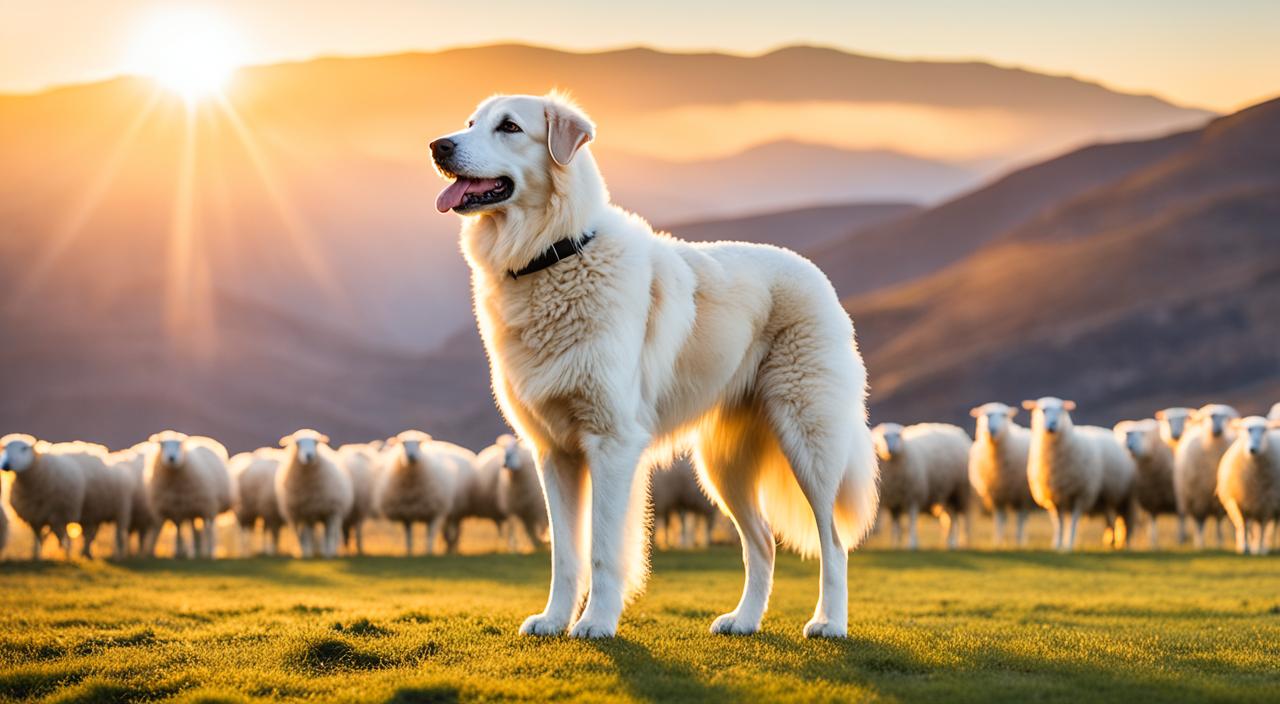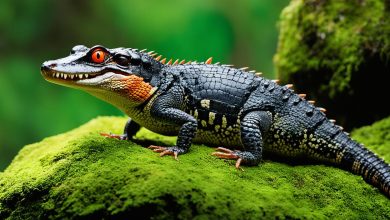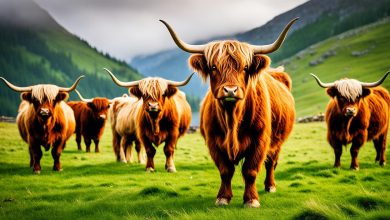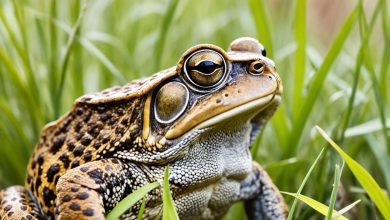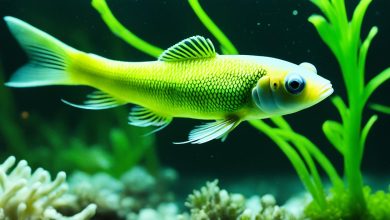Our Akbash dog, Thor, stood tall on our family farm. He watched over the flock with keen eyes. His majestic white figure embodied strength and loyalty.
The Akbash is a Turkish livestock guardian dog. These large white dogs have protected flocks for over 3,000 years. Males can weigh up to 140 pounds and stand 30 inches tall.
The United Kennel Club recognized the Akbash in 1998. They’ve grown popular in North America. These dogs take two to three years to mature fully.
Akbash dogs blend Mastiff and gazehound traits. This mix gives them both power and agility. These qualities make them perfect for their guardian role.
The Akbash’s calm nature makes it an exceptional guardian. They form deep bonds with those they protect. Thor’s dedication reminds me of their enduring legacy as guardians.
Introduction to the Akbash Dog Breed
The Akbash Dog is a special breed from western Turkey. In Turkish, it’s called Akbaş çoban köpeği. This big, white dog is known for guarding livestock and being loyal.
Origin and History
The Akbash Dog comes from Turkey and belongs to Turkish herding dogs. Its name means “white head” in Turkish. For hundreds of years, it has protected flocks from danger.
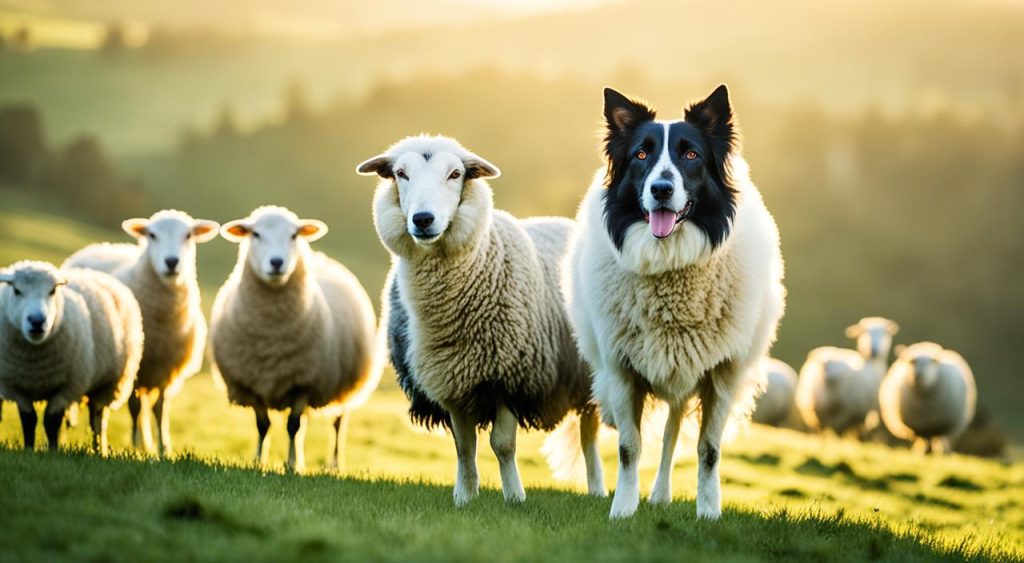
Breed Recognition
People in the United States first saw Akbash Dogs in the 1970s. The United Kennel Club officially recognized the breed in 1998. This made the Akbash Dog more well-known worldwide.
Purpose and Role
The Akbash Dog’s main job is to guard sheep and other farm animals. It keeps them safe from animals that might hurt them. This breed is good at protecting many different kinds of animals.
| Characteristic | Description |
|---|---|
| Height | 27 to 32 inches |
| Weight | 80 to 140 pounds |
| Lifespan | 10 to 12 years |
| Color | White |
| Exercise Needs | 30 minutes to 1 hour daily |
The Akbash Dog is similar to the Anatolian Shepherd Dog. It works well on big ranges and small farms. This breed is a mix of gazehound and mastiff.
This blend gives the Akbash Dog speed, grace, and strength. These traits make it different from other Turkish herding dogs.
Physical Characteristics of the Akbash Dog
The Akbash dog is a large white breed with impressive physical attributes. Its majestic appearance and powerful build make it an ideal guardian. This breed excels at protecting livestock and homes.
Size and Weight
Akbash shepherd dogs are known for their large size. Males are typically taller and heavier than females. Here’s a breakdown of their average measurements:
| Gender | Height (inches) | Weight (pounds) |
|---|---|---|
| Male | 28-34 | 80-140 |
| Female | 26-32 | 60-120 |
Coat and Color
The Akbash dog has a medium-length double coat that’s pure white. It sheds moderately year-round, needing regular grooming to stay pristine. The white color helps shepherds spot these dogs in low light.
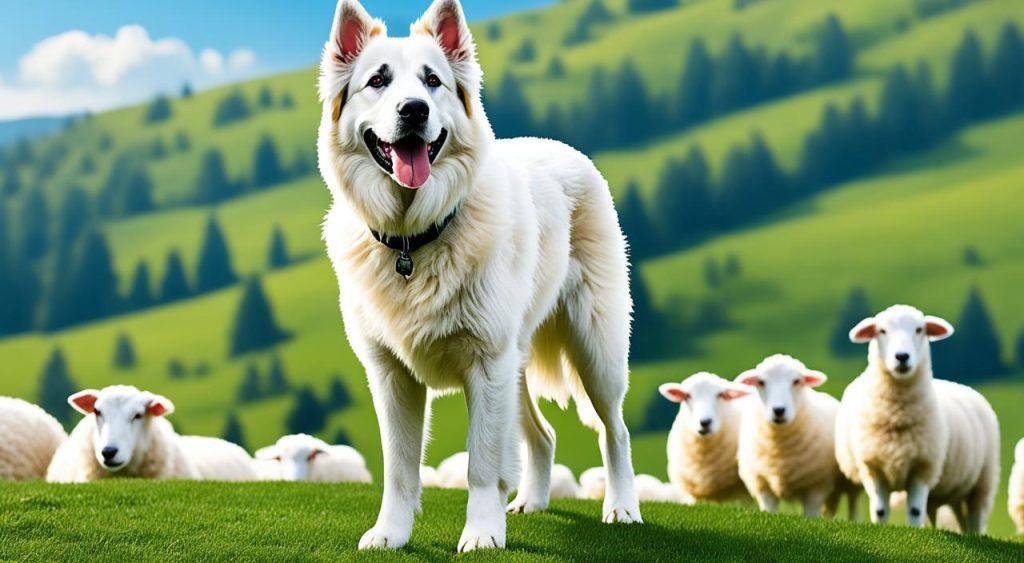
Distinctive Features
Akbash dogs have unique traits that set them apart from other large white breeds. They have a wedge-shaped head and almond-shaped eyes. Their long tail often curls over the back when alert or moving.
These features give them a noble and imposing presence. This appearance reflects their role as guardians.
Temperament and Personality Traits
Akbash dogs are powerful guardians with a unique temperament. Their calm and steady nature makes them excellent protectors for flocks and families. These dogs are known for their independent thinking and decision-making skills.
Akbash dogs can make quick judgments without constant human direction. This trait is invaluable in their role as livestock protection dogs. They excel at guarding animals and making split-second decisions.
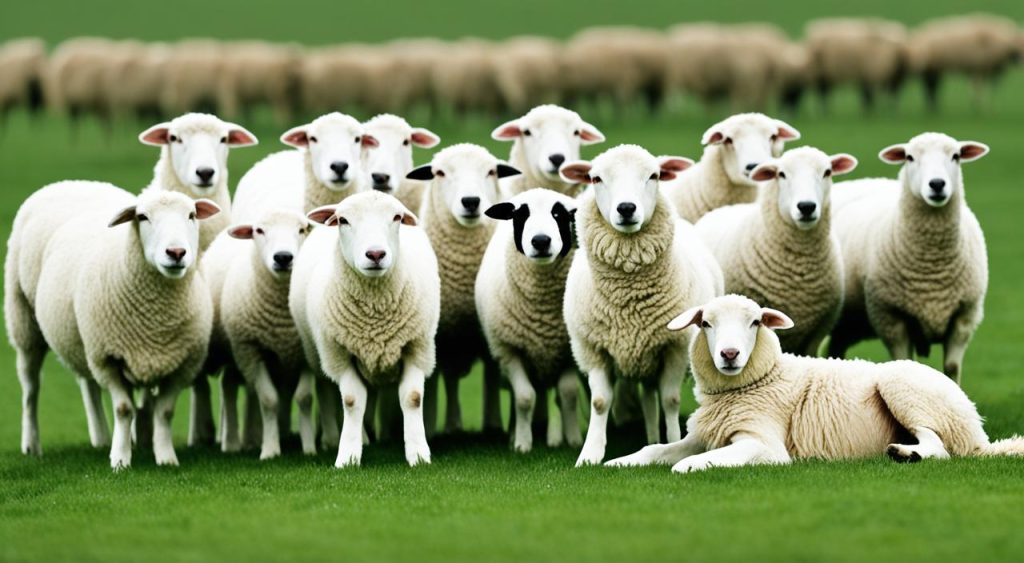
With their families, Akbash dogs are loyal and gentle. They remain cautious around strangers and stay alert to potential threats. This mix of affection and vigilance makes them ideal guards for homes and farms.
| Trait | Level |
|---|---|
| Affection | Medium |
| Friendliness | Low |
| Kid-Friendly | Low |
| Pet-Friendly | Low |
| Intelligence | High |
Adult Akbash dogs have low energy levels and playfulness. They need minimal exercise but require mental stimulation to avoid boredom. Early socialization is key to prevent overly suspicious behavior in new situations.
“The Akbash is a protective breed that tends to watch over its family from a central or high area, actively guarding them from potential threats.”
Akbash dogs respond well to positive reinforcement training. Their high intelligence and independent nature can make training challenging. However, consistent and patient guidance leads to excellent results.
Akbash Dog as a Livestock Guardian
Akbash dogs are top-notch livestock guardians. They have strong protective instincts and excellent working abilities. These dogs are priceless assets for farmers and ranchers.
Protective Instincts
Akbash dogs have a natural drive to protect. They watch over their territory and patrol regularly. These dogs may move the flock away from danger or face predators head-on.
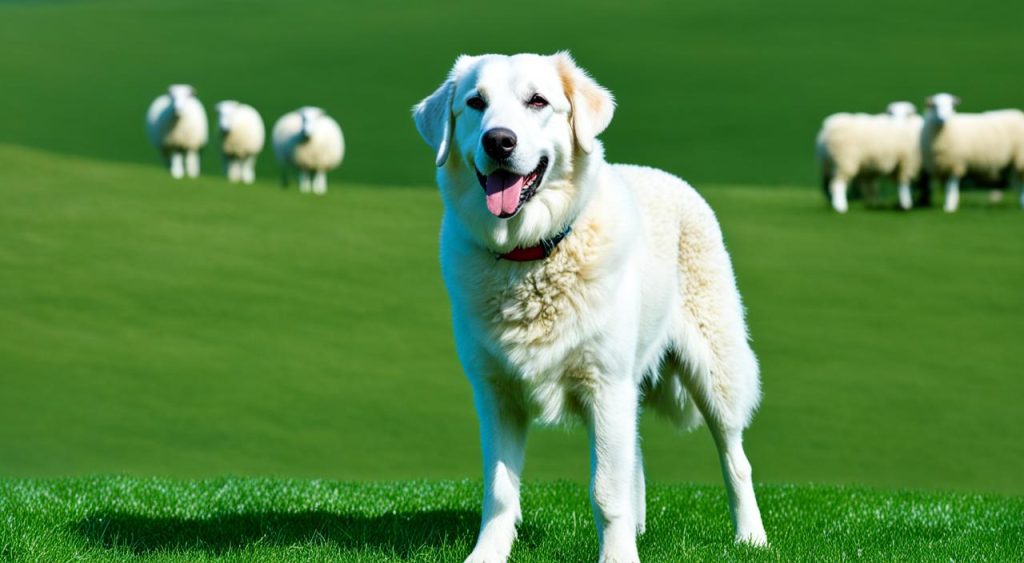
Working Abilities
Akbash dogs are effective against many predators, from wolves to bears. They use their size, strength, and smarts to scare off threats. Male Akbash dogs are usually 29-32 inches tall and weigh 90-130 lbs.
Females are slightly smaller at 27-30 inches tall and 75-100 lbs. Their impressive size helps them protect their flocks.
Bonding with Livestock
Akbash dogs form close bonds with the animals they protect. This deep connection keeps them alert and devoted to their flock’s safety. The strong bond helps livestock feel safe around their canine guardian.
“Akbash dogs are independent-minded and resistant to conventional training methods, making them true guardians rather than obedient pets.”
Akbash dogs need proper socialization and training. This helps them tell real threats from harmless visitors. With the right guidance, they become excellent flock guardians.
Training and Socialization Requirements
Akbash dogs need patient and consistent training. These Turkish livestock guardians are smart but independent. Early socialization is vital, and puppy classes can help with both training and socializing.
Begin training your Akbash puppy as soon as it arrives home. Teach basic commands like “come” and “sit” right away. Daily handling and mental stimulation boost learning and stress management skills.
Introduce your pup to different people and places. This helps develop good decision-making abilities. Akbash dogs learn fast in their first 16 weeks.
Close supervision is crucial for shaping good behavior. Correct bad actions quickly, especially around livestock. Well-supervised Akbash puppies usually become livestock-safe between six months and a year.
Akbash dogs grow up slowly, often outgrowing puppy behaviors by age two or three. Keep training consistent through adolescence. The seven to ten-month period can be challenging.
With patience, your Akbash will become a loyal, well-behaved companion. Remember, these dogs need ongoing guidance to reach their full potential.
“Training an Akbash dog is a journey that requires dedication, but the rewards of a well-behaved guardian are immeasurable.”
Exercise Needs and Activity Level
Akbash shepherd dogs need lots of physical and mental exercise to stay healthy. These large white dogs have high energy levels. Regular activity is crucial for their well-being.
Daily Exercise Requirements
Akbash dogs need plenty of daily physical activity. A long walk or jog, plus playtime in a fenced yard, helps meet their needs. Their size and energy make them unsuitable for apartments.
Mental Stimulation
Akbash shepherd dogs also need mental challenges. Puzzle toys, obedience training, and interactive games can keep their minds sharp. These activities prevent boredom and potential destructive behaviors.
Space Considerations
Akbash dogs thrive in large yards or rural settings. Their size and wandering nature require a spacious, secure area. Without proper space, these dogs may become restless or misbehave.
| Exercise Type | Frequency | Duration |
|---|---|---|
| Walks/Jogs | Daily | 60-90 minutes |
| Playtime | 2-3 times daily | 15-30 minutes |
| Mental Stimulation | Daily | 30-45 minutes |
Meeting these exercise and space needs keeps Akbash shepherd dogs happy and healthy. Regular activity maintains their physical health. It also strengthens the bond between dog and owner.
Health Concerns and Lifespan
Akbash dogs, Turkish livestock guardians, typically live 10 to 12 years. These robust canines usually stay healthy throughout their lives. However, they can face certain health challenges.
Common issues include hip and elbow dysplasia, and eye problems. Bloat, a serious condition, requires immediate vet care. Some Akbash dogs might develop hypothyroidism or dilated cardiomyopathy.
Regular vet check-ups are crucial for your Akbash’s well-being. These visits help catch potential health issues early. A balanced diet and exercise routine also keep your dog healthy.
- Weight range: 90-130 pounds
- Height range: 28-32 inches
- Exercise needs: 30-60 minutes daily
Akbash dogs need proper nutrition for their large frame. They require 22% to 28% protein intake, with puppies needing up to 32%. Every Akbash is unique, so consult your vet for a tailored health plan.
Grooming and Maintenance
Akbash shepherd dogs need regular care to stay healthy. These big white dogs require consistent grooming to look their best. Regular maintenance helps keep them in top shape.
Coat Care
Akbash dogs have a hard, clean coat that doesn’t mat easily. They shed moderately all year, so brush them often. During shedding seasons, step up the brushing to keep their white coat pristine.
Nail Trimming and Dental Hygiene
Trim your Akbash’s nails regularly to prevent discomfort. Brush their teeth often to avoid dental problems and bad breath. These habits keep your dog healthy and strengthen your bond.
Bathing Frequency
Akbash dogs don’t need frequent baths due to their clean coat. Bathe them every few months or when they get very dirty. Their white coat may need extra care to stay bright.
Use a gentle dog shampoo to protect their skin’s natural oils. Good grooming helps spot skin issues early. It keeps your Akbash comfy during their 10-12 year lifespan.
Akbash Dog as a Family Companion
Akbash dogs, Turkish livestock guardians, can be great family pets when well-socialized. These gentle giants love their families, especially kids. They’re protective at home, just like with livestock.
Adult Akbash dogs are calm and low-energy, fitting well into family life. They bond strongly with household pets. These clean dogs are easy to housebreak, preferring grass for their business.
Weekly brushing keeps Akbash dogs well-groomed, with extra care during shedding season. Young Akbash need space to run and exercise. A secure, fenced yard is vital for their safety.
“Akbash dogs are cool, peaceful, and independent companions with strong loyalty to their family members.”
When choosing an Akbash, find an experienced breeder to match your family’s needs. Both males and females make good companions. It’s best to neuter males around 7 months old.
| Characteristic | Description |
|---|---|
| Temperament | Cool, independent, vigilant |
| Family Compatibility | Good with children, affectionate towards family |
| Other Pets | Generally compatible, protective of smaller animals |
| Space Requirement | Prefers countryside, needs room to move |
| Grooming Needs | Weekly brushing, more during shedding season |
Choosing and Adopting an Akbash Dog
Akbash shepherd dogs are known for their loyalty and protective nature. These large white dogs need plenty of space to move around. Males can weigh up to 120 pounds and stand 34 inches tall.
Look for reputable breeders or consider adopting from rescue groups. Akbash puppies cost between $600 and $2000, depending on their lineage. These dogs live 10 to 12 years, making them a long-term commitment.
Akbash dogs aren’t ideal for first-time owners due to their strong will. They’re highly watchful but not very friendly to strangers or other dogs. Regular grooming and exercise are essential for their well-being.
Health issues like hip dysplasia and epilepsy may affect Akbash dogs. Before adopting, ensure you’re ready for their unique blend of guardian instincts and family loyalty.
FAQ
Where does the Akbash dog breed originate from?
The Akbash dog breed comes from western Turkey. For centuries, they’ve guarded sheep against predators. These dogs excel at protecting livestock.
When was the Akbash dog breed recognized?
The United Kennel Club officially recognized the Akbash in 1998.
What are the distinctive physical features of the Akbash dog?
Akbash dogs are large with a white, medium-length double coat. They have a wedge-shaped head and almond-shaped eyes.
Their long tail often curls over the back when alert or moving.
What is the temperament of Akbash dogs?
Akbash dogs are calm, quiet, and steady. They think independently and show loyalty to their family.
These dogs are gentle and affectionate at home. However, they remain wary of strangers.
How do Akbash dogs protect livestock?
Akbash dogs use surveillance and patrolling to guard livestock. They move animals away from danger and challenge predators.
Sometimes, they even “bait” threats to protect their charges.
Are Akbash dogs easy to train?
Early socialization and training are crucial for Akbash dogs. They respond well to positive reinforcement methods.
However, their independent nature can make training challenging.
What are the exercise needs of Akbash dogs?
Akbash dogs need moderate to high exercise daily. They require physical activity and mental stimulation to stay healthy.
A large, securely fenced area is ideal for these dogs.
What are the common health concerns for Akbash dogs?
Akbash dogs may develop hip dysplasia, elbow dysplasia, bloat, and eye problems. Regular vet check-ups help prevent or manage these issues.
A healthy diet and exercise routine are also important.
How often should Akbash dogs be groomed?
Brush Akbash dogs regularly to remove dead hair and prevent matting. Trim their nails and maintain dental hygiene.
Bathe them every few months or when they get dirty.
Are Akbash dogs good family companions?
Well-socialized Akbash dogs make great family companions. They’re gentle with children and family pets.
Their protective nature makes them good guardians. However, they may be wary of unfamiliar dogs.
These large, independent dogs suit experienced owners with ample space.
